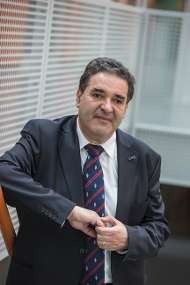Mikhail Katsnelson
Mikhail Iosifovich Katsnelson (Russian: Михаил Иосифович Кацнельсон; born 10 August 1957) is a Dutch professor of theoretical physics of Russian descent. He works at Radboud University Nijmegen where he specializes in graphene ripples.[1]
Mikhail Katsnelson | |
|---|---|
 | |
| Born | August 10, 1957 |
| Alma mater | Ural State University Institute of Metal Physics |
| Awards | Spinoza Prize (2013) |
| Scientific career | |
| Fields | Physics |
| Institutions | Radboud University Nijmegen |
Early life
Katsnelson was born in Magnitogorsk, Russia. From 1972-1977 he attended and then graduated from the Ural State University in Sverdlovsk. In 1980 he obtained his Ph.D. from Institute of Metal Physics in the same place where his advisor was Serghey V. Vonsovsky. In 1985 he defended his thesis for his Doctor of Science degree called Strong electron correlations in transition metals, their alloys and compounds and from 1990 to 1998 became Max-Planck-Institute visiting professor.[2]
Career
From 2004 to 2007 Katsnelson worked with many Russian and Dutch physicists on the nitrogen dioxide and discovered that by combining it with tetraoxygen it creates only weak doping which is also known as density of states in a grapheme. He also discovered that density of states is ideal for chemical sensing and explained its single molecule detection.[3] On 23 September 2007 he along with Annalisa Fasolino have proven that chemical bonding in carbon is caused by setting ripples' thermal fluctuations to 80 angstrom.[4] In 2010 Katsnelson worked with physicists from India such as Rashid Jalil, Rahul R. Nair, and nanotechnologist Fredrik Schedin of University of Manchester and have discovered that fluorine atoms are attached to the carbon of the graphene therefore creating a new version called fluorographene that can be stable in the air with a temperature of 400 °C (752 °F).[5] In 2012 he and his colleagues have used prototype device which contained graphene heterojunctions which was combined with either thin boron nitride or molybdenum disulfide which was used as a vertical transport barrier. During the experiment, the room temperature was set from ≈50 and ≈10,000 and they prove that using such prototypes is beneficial for high-frequency operations and large-scale integrations.[6]
Since 2014 Katsnelson is member of the Royal Netherlands Academy of Arts and Sciences.[7]
Awards
- Lenin Komsomol Prize (1988)
- Spinoza Prize (2013)[8]
References
- John Matson (18 November 2009). "Ultrathin, Now Ultraflat: Ripple-Free Graphene May Hold Key to Material's Mysteries". Scientific American. Retrieved 21 January 2015.
- "Homepage of Mikhail I. Katsnelson". Archived from the original on 21 January 2015. Retrieved 21 January 2015.
- Wehling, T. O.; Novoselov, K. S.; Morozov, S. V.; Vdovin, E. E.; Katsnelson, M. I.; Geim, A. K.; Lichtenstein, A. I. (2008). "Molecular Doping of Graphene". Nano Letters. 8 (1): 173–177. arXiv:cond-mat/0703390. Bibcode:2008NanoL...8..173W. doi:10.1021/nl072364w. PMID 18085811.
- A. Fasolino; J. H. Los; M. I. Katsnelson (2007). "Intrinsic ripples in grapheme". Nature Materials. 6 (11): 858–861. arXiv:0704.1793. Bibcode:2007NatMa...6..858F. doi:10.1038/nmat2011. PMID 17891144.
- Nair, Rahul R.; Ren, Wencai; Jalil, Rashid; Riaz, Ibtsam; Kravets, Vasyl G.; Britnell, Liam; Blake, Peter; Schedin, Fredrik; Mayorov, Alexander S.; Yuan, Shengjun; Katsnelson, Mikhail I.; Cheng, Hui-Ming; Strupinski, Wlodek; Bulusheva, Lyubov G.; Okotrub, Alexander V.; Grigorieva, Irina V.; Grigorenko, Alexander N.; Novoselov, Kostya S.; Geim, Andre K. (20 December 2010). "Fluorographene: A Two-Dimensional Counterpart of Teflon". Small. 6 (24): 2877–2884. arXiv:1006.3016. doi:10.1002/smll.201001555. PMID 21053339.
- Britnell, L.; Gorbachev, R. V.; Jalil, R.; Belle, B. D.; Schedin, F.; Mishchenko, A.; Georgiou, T.; Katsnelson, M. I.; Eaves, L.; Morozov, S. V.; Peres, N. M. R.; Leist, J.; Geim, A. K.; Novoselov, K. S.; Ponomarenko, L. A. (24 February 2012). "Field-Effect Tunneling Transistor Based on Vertical Graphene Heterostructures". Science. 335 (6071): 947–950. arXiv:1112.4999. Bibcode:2012Sci...335..947B. doi:10.1126/science.1218461. PMID 22300848.
- "Misha Katsnelson" (in Dutch). Royal Netherlands Academy of Arts and Sciences. Retrieved 30 June 2015.
- "NWO Spinoza Prize 2013". Netherlands Organisation for Scientific Research. 3 September 2014. Retrieved 25 June 2015.
External links
- Mikhail Katsnelson publications indexed by Google Scholar
- Michail Katsnelson, NWO-Spinozalaureaat 2013 on YouTube